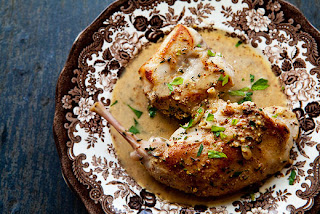 |
| Bourbon Red Turkey Poults - Photo Credit: Porter Turkeys |
It was a little difficult to think about - especially for our resident Farm Boy, who had become very enamored with their cheerful "gooblle gooblle goooobllle!" every morning when feeding. They were beautiful and friendly, if quite smelly. A lot smellier than chickens. Anyway, I digress.
We were a little nervous and kinda sad about doing the actual harvesting.
So we brought in reinforcements for a Plucking Par-Tay.
We invited some friends who were skunked last year for Thanksgiving when their specially ordered heritage breed turkey didn't appear at Whole Foods like promised. It didn't hurt that one of them had insane surgical skills like Dear Hubby, and she knew what he was taking about when he referenced "cut circumferentially" and what the xiphoid process, trachea, and other miscellaneous bits of the Turkey were...
We were also joined by a couple of our other good friends, who raised turkeys themselves this year, but had their "turkey processor" go "flaky." So they needed to do the harvesting... and weren't too jazzed about doing it alone.
The more the merrier, I say... and having Mimosas and Bloody Marys to drink beforehand didn't hurt, either.
So, we started with Google. What did we do before Google?? Honestly??? Anyway, we found the Howling Duck Ranch blog that thankfully posted step-by-step "how to butcher a turkey," complete with graphic photos and very clear descriptions. I highly recommend reading it through if you're considering harvesting your own turkey. Totally helpful, and the "hating" comments afterward, about how butchering your own food is the primary reason for the decline of western civilization, are rather funny to read...
Again, I digress... might be the Bloody Mary(s).
So here's the set-up. Place to hang 'em. Check! Place to scald 'em. Check! Place to pluck 'em. Check! Sterilized dunking bucket. Check!
We decided that we really couldn't procrastinate any longer, so - up went the turkeys. (Note: From here on in, there's gonna be blood and guts. Don't scroll down any further unless you want to see it all.)
 |
| Yes, Farm Boy has a Mohawk. Not my choice of haircut, but he says the girls like it.... hmmm. |
We had our two Bourbon Reds, and they had their two Royal Palm-ish (mystery breed, really) toms. Aren't they gorgeous? The turkeys aren't bad, either! <<snicker, snicker, snort>>
At this point, the ladies went in to admire some lovely gingerbread muffins rather than sticking around for the cutting of the throats and crazy wing flapping. There was a lot of wing flapping.
Then it was time for another mimosa, followed by a time for scalding & plucking.
While scalding, we quickly found out that even with these smallish birds - our really large beer making pot really wasn't big enough. We need something much bigger, with room to swish and dunk the bird. So - we ended up over scalding the birds a bit trying to cram them into the too-small pot.
Then the plucking - which I had truly dreaded. I'd heard it took forever, was messy, and just a general pain in the patootie. It wasn't, though.
We had seven people plucking four turkeys (and a great photographer, obviously). Surprisingly, it didn't take all that long. It was - dare I say it? - kind of fun, actually. One of the turkeys had a grizzly, bristly beard. All of them had gnarly feet. They kind of all smelled like... um... wet dog.
None had huge Franken-breasts. In fact, I don't think any of them were bigger than 12-14 lbs. Organic, hormone and soy-free feed. Makes you wonder what those Butterballs are fed and dosed with, hm?
 |
| The feathers actually came out really easy. Note for next time, though: BIGGER SCALDING POT |
Many hands truly do make light work. There was much joking, laughing, and statements of "gross!" from the kiddo peanut gallery when consulted for thoughts on the matter.
Luckily, our photographer didn't pass out.
 |
| Almost featherless. Not bloody. Yet. |
 |
| Cutting "circumferentially" around the neck. |
 |
| Peeling back the neck skin to find the trachea and blood vessels. |
Ok, now we get to the "innards." Turkeys are just built differently. Their stomachs are way up high, and you get it out through the neck area. They have weird "gizzards" that - when you cut them open -have rocks inside. Please note: The photos from here on out DO include blood, guts, and miscellaneous other bits you only see when, well, butchering an animal for food.
 |
| Removing the stomach. Those surgeons really came in handy. They like sharp knives. |
 |
| Probably the most "gross" photo in the string... that's his trachea, stomach, neck and head... |
Then, after you've removed the neck and the stomach, it's time for.... the other end.
 |
| You have to remove the oil gland, which is right above the anus. For some reason, we all thought that was really funny. |
 |
| More fun at the "other" end. |
So, it's interesting, but you actually remove all the guts - including the gizzard - AND the lungs from the, umm, other end. Hubby is removing the lungs (that he insisted were orange - but were more "coral" in the opinions of the ladies).
 |
| This doesn't look good. I know. |
 |
| Doing something you never really thought you'd do? |
 |
| Opening and demonstrating the rocks in the gizzard. You peel the membrane back, and it's perfectly good for adding to the stock and making turkey gravy. |
Then, it was just time to pretty up the bird... cut off the nasty feet and then dunk in the rinse barrel. I think the photographer got a little bored, and he didn't take photos of the barrel.
But he did get a photo of the trash basket.

























